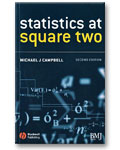Statistics at Square Two, 2nd Edition
Book Info
Author: Michael J. Campbell 公卫考场
Publisher: Blackwell Publishing
Copyright: 2006
ISBN-10: 1-4051-3490-9
ISBN-13: 978-1-4051-3490-3
Pages: 144; paperback
Price: $29.75
Comments from the Stata technical group
Statistics at Square Two, Second Edition, by Michael J. Campbell, is an updated version of the sequel (published in 2001) to the popular Statistics at Square One, published more than 30 years ago. At just over 140 pages, this text contains a lot of useful information. Intended as a quick reference of statistical methods prevalent in medical literature, Statistics at Square Two does not contain much theory; instead, Campbell focuses on the practical application of these methods. The text explains the benefits and pitfalls of these various methodologies and includes complete references, exercises, and frequently asked questions at the end of each chapter. Campbell uses Stata 8 throughout this text.
公卫考场
Like its predecessor, this text covers classical analyses such as means and medians, t tests, and chi-squared tests. The text also covers the more complex methods that have become available to medical researchers through advances in computer technology. The newer methods the text covers include multiple regression, logistic regression, survival analysis including Cox regression, random-effects models, and Poisson and ordinal regression. 公卫考场
Table of contents
Preface Chapter 1: Models, tests and data
1.1 Basics
1.2 Models
1.3 Types of data
1.4 Significance tests
1.5 Confidence intervals
1.6 Statistical tests using models
1.7 Model fitting and analysis: confirmatory and exploratory analyses 公卫家园
1.8 Computer-intensive methods
1.9 Bayesian methods
1.10 Missing values
1.11 Reporting statistical results in the literature
1.12 Reading statistics in the literature
Chapter 2: Multiple linear regression
2.1 The model
2.2 Uses of multiple regression
公卫考场
2.3 Two independent variables
2.4 Interpreting a computer output
2.5 Multiple regression in action
2.6 Assumptions underlying the models
2.7 Model sensitivity
2.8 Stepwise regression
2.9 Reporting the results of a multiple regression
公卫考场
2.10 Reading the results of a multiple regression
Chapter 3: Logistic regression
3.1 The model
3.2 Uses of logistic regression
3.3 Interpreting a computer output: grouped analysis
3.4 Logistic regression in action
3.5 Model checking
公卫百科
3.6 Interpreting computer output: grouped analysis
3.7 Case–control studies
3.8 Interpreting computer output: unmatched case–control studies
3.9 Matched case–control studies
3.10 Interpreting computer output: matched case–control studies
公卫考场
3.11 Conditional logistic regression in action
3.12 Reporting the results of logistic regression
3.13 Reading about logistic regression
Chapter 4: Survival analysis
4.1 Introduction
4.2 The model
4.3 Uses of Cox regression
4.4 Interpreting a computer output 公卫人
4.5 Survival analysis in action
4.6 Interpretation of the model
4.7 Generalizations of the model
4.8 Model checking
4.9 Reporting the results of a survival model
4.10 Reading about the results of a survival model
Chapter 5: Random effects model 公卫家园
5.1 Introduction
5.2 Models for random effects
5.3 Random vs. fixed effects
5.4 Use of random effects models
5.5 Random effects models in action
5.6 Ordinary least squares at the group level
5.7 Computer analysis
5.8 Model checking 公卫论坛
5.9 Reporting the results of random effects analysis
5.10 Reading about the results of random effects analysis
Chapter 6: Other models
6.1 Poisson regression
6.2 Ordinal regression
6.3 Time series regression
6.4 Reporting Poisson, ordinal or time series regression in the literature
公卫论坛
6.5 Reading about the results of Poisson, ordinal or time series regression in the literature
Appendix 1: Exponentials and logarithms
A1.1 Logarithms
Appendix 2: Maximum likelihood and significance tests
A2.1 Binomial models and likelihood 公卫人
A2.2 Poisson model
A2.3 Normal model
A2.4 Hypothesis testing: LR test
A2.5 Wald test
A2.6 Score test
A2.7 Which method to choose?
A2.8 Confidence intervals
Appendix 3: Bootstrapping and variance robust standard errors
A3.1 Computer analysis 公卫百科
A3.2 The bootstrap in action
A3.3 Robust or sandwich estimate
A3.4 Reporting the bootstrap and robust SEs in the literature
Appendix 4: Bayesian methods
A4.1 Reporting Bayesian methods in the literature
Answers to exercise
Glossary
公卫考场
Index
附件列表
您所在的用户组无法下载或查看附件
词条内容仅供参考,如果您需要解决具体问题
(尤其在法律、医学等领域),建议您咨询相关领域专业人士。
如果您认为本词条还有待完善,请 编辑
上一篇 Statistics for Epidemiology 下一篇 Statistical Models in Epidemiology


